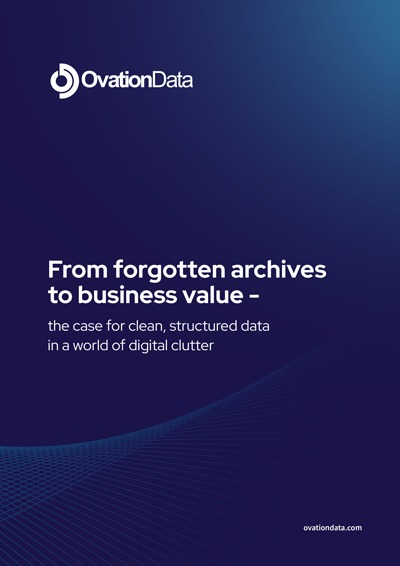By 2026, the world will generate more than 221 zettabytes of data annually, an astonishing volume that’s more than humanity produced in the first 5,000 years of recorded history, every single year. Yet, despite this unprecedented growth, around 80% of that data will remain dormant, unused, inaccessible, and slowly degrading.
Without action, we risk losing invaluable knowledge bit by bit, a loss as profound as the burning of the Library of Alexandria, an irreversible setback that could hold back progress for generations.
Why Data Readiness Matters
Data is no longer just a technical issue; it is a strategic imperative. How can we expect AI, machine learning, and knowledge-based systems to transform society and drive business success when so much critical information remains buried and neglected? To harness the full potential of our data-driven future, we must prioritize data preservation and breathe new life into the invaluable historical data still gathering dust.
The risks of data neglect and strategies to address this are the topic of Ovation Data’s latest white paper, From Forgotten Archives to Business Value – The Case for Clean, Structured Data in a World of Digital Clutter. In it we explain why organizations across industries must prioritize data readiness to stay competitive and efficient, offering practical guidance and real-world insights.
Through our experience of working with data-intensive industries such as oil and gas, heritage, and biotech, we’ve observed that organizations that lack structured data struggle with inefficiencies, compliance risks, and missed opportunities.
In biotech, for example, researchers can spend up to 80% of their time cleaning data rather than analyzing it—a significant barrier to faster scientific breakthroughs. In energy, the inability to access and use seismic data can lead to project delays and unnecessary costs, sometimes reaching millions per day. Meanwhile, in the heritage sector, unstructured digitized archives can be just as inaccessible as the paper records they replace.
The Costs of Data Neglect
| Financial Loss | Wasted time and duplicated efforts drain resources. |
| Regulatory Risk | Incomplete or inaccessible data can lead to non-compliance and fines. |
| Lost Insight | Valuable discoveries and innovations remain hidden. |
| Missed Collaboration | Teams and partners struggle to share insights across incompatible systems. |
The Competitive Advantage of Structured Data
Taking control of your data helps build a resilient, agile organization that can adapt to change and seize new opportunities. Regardless of the industry sector, structured data empowers organizations to innovate, connect, and thrive.
Our white paper highlights Moderna’s rapid response to the COVID-19 pandemic. Its ability to develop a vaccine quickly was driven by structured, clean data that enabled seamless access and integration across research and development. Applied more widely, these principles of structured data have the potential to transform scientific collaboration – enabling seamless information sharing, reducing duplication, and accelerating the discovery of new diagnostics and treatments for the benefit of communities worldwide.
The ability to share and collaborate on resources is also invaluable for cultural institutions. Adding metadata to digital collections takes an archive from inert data to a rich, interconnected resource, unlocking new discoveries and creating interactive, innovative ways to engage the public and scholars alike.
There are similar benefits to be gained in prioritizing data readiness in the energy and geosciences sector. By transforming fragmented, legacy records into accessible, searchable resources, companies can quickly address regulatory demands, demonstrate accountability, and make informed decisions about resource management. This proactive approach not only helps companies avoid fines and compliance issues but also supports responsible energy use, all key factors in building public trust and fostering long-term resilience.
Why Now? The Urgency of Data Transformation
As digital intelligence and AI become fundamental to innovation, organizations can no longer afford to let valuable data remain dormant and disorganized.
This isn’t just a technical issue; it’s a challenge with far-reaching societal implications. Data is the foundation of progress in healthcare, energy, education, and countless other sectors. Whether it’s using AI to identify new treatments, analyzing trends to forecast energy needs, or preserving cultural heritage for future generations, structured data is essential to making informed decisions and responding to society’s growing demands.
If we fail to act, we risk losing irreplaceable knowledge and missing opportunities to improve lives, drive innovation, and maintain organizational relevance. Prioritizing data readiness is not just about avoiding loss—it’s about ensuring we can fully harness data’s potential to build a more resilient, informed, and sustainable future.
Taking the First Step

Achieving data readiness begins by adopting a mindset that values data as a strategic asset. Organizations must move beyond ad hoc digitization and commit to structured, sustainable data practices that maximize value and minimize risk.
Our new white paper is essential reading for business leaders seeking to make data readiness a strategic priority. It demonstrates why clean, structured data is not just a technical upgrade but a fundamental step towards building resilient, data-driven organizations.
If you’re ready to transform your data into a strategic asset, download our new white paper From Forgotten Archives to Business Value – The Case for Clean, Structured Data in a World of Digital Clutter.